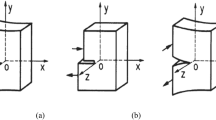Abstract
Crack is found to be a major distress that affects the performance of the epoxy asphalt pavement. An extended finite element method was proposed for investigating the fracture properties of the epoxy asphalt mixture. Firstly, the single-edge notched beam test was used to analyze the temperature effect and calculate the material parameters. Then, the mechanical responses were studied using numerical analysis. It is concluded that 5 °C can be selected as the critical temperature that affects the fracture properties, and numerical simulations indicate that crack propagation is found to significantly affect the stress state of the epoxy asphalt mixture. The maximum principal stress at the crack surface exhibits different trends at various temperatures. Numerical solution of stress intensity factor can well meet the theoretical solution, especially when the temperature is lower than 5 °C.
Similar content being viewed by others
References
QIAN Zhen-dong, HAN Guang-yi, HUANG Wei. A study on crack fatigue propagation of steel deck pavement based on BOTDA [J]. China Civil Engineering Journal, 2009, 42(10): 132–136. (in Chinese)
BAEK J, IMAD L, Al Q. Finite element modeling of reflective cracking under moving vehicular loading: Investigation of the mechanism of reflective cracking in hot-mix asphalt overlays reinforced with interlayer systems [J]. Airfield and Highway Pavements, 2008: 74–85.
SEONG H S, GLAUCIO H P, WILLIAM G B. A bilinear cohesive zone model tailored for fracture of asphalt concrete considering viscoelastic bulk material [J]. Engineering Fracture Mechanics, 2006, 73: 2829–2848.
MO L T, HURMAN M, WU S P, MOLENAAR A A A. 2D and 3D meso-scale finite element models for ravelling analysis of porous asphalt concrete [J]. Finite Elements in Analysis and Design, 2008, 44: 186–196.
ARAGAO F T S, KIM Y R, LEE J H, ALLEN D H. Micromechanical model for heterogeneous asphalt concrete mixtures subjected to fracture failure [J]. Journal of Materials in Civil Engineering, 2011, 32(1): 30–38.
LI Xin-jun, MARASTEANU M. The fracture process zone in asphalt mixture at low temperature [J]. Engineering Fracture Mechanics, 2010, 77: 1175–1190.
BANDYOPADHYAYA R, DAS A, BASU S. Numerical simulation of mechanical behaviour of asphalt mix [J]. Construction and Building Materials, 2008, 22: 1051–1058.
CARO S, MASAD E, BHASIN A, LITTLE D. Coupled micromechanical model of moisture-induced damage in asphalt mixtures [J]. Journal of Materials in Civil Engineering, 2010, 22(4): 380–388.
DAI Qing-li, YU Xiong, KENNY N, ZHOU Jun. Micromechanics models and innovative sensor technologies to evaluate internal-frost damage of concrete [R]. Nondestructive Characterization for Composite Materials, Aerospace Engineering, Civil Infrastructure, and Homeland Security, 2011.
ABDELAZIZ Y, HAMOUINE A. A survey of the extended finite element [J]. Computers & Structure, 2008, 86: 1141–1151.
BELYTSCHKO T, BLACK T. Elastic crack growth in finite elements with minimal remeshing [J]. International Journal for Numerical Methods in Engineering, 1999, 45(5): 601–620.
KENNY N, DAI Qing-li. Investigation of fracture behavior of heterogeneous infrastructure materials with extended finite element method and image analysis [J]. Journal of Materials in Civil Engineering, 2011, 23(12): 1–39.
XU Yang-jian, HUANG Yuan. On damage accumulations in the cyclic cohesive zone model for XFEM analysis of mixed-mode fatigue crack growth [J]. Computational Materials Science, 2009, 46: 579–585.
SETHIAN J A. Level set methods and fast marching methods: evolving interfaces in computational geometry [M]. UK: Cambridge University Press, 1999: 68–72.
SHET C, CHANDRA N. Analysis of energy balance when using cohesive zone models to simulate fracture processes [J]. Journal of Engineering Materials and Technology, 2002, 124: 440–450.
JENQ Y S, SHAH S P. Two parameter fracture model for concrete [J]. Journal of Engineering Mechanics, 1985, 110(10): 1227–1241.
KIM H, WAGONER M P, BUTTLAR W G. Numerical fracture analysis on the specimen size dependency of asphalt concrete using a cohesive softening model [J]. Construction and Building Materials, 2009, 23: 2112–2120.
YING Zhong-quan, DU Cheng-bin, LIU Bing. Meso-scopic analysis of fracture process of concrete beam under bending [J]. Journal of Southeast University: Natural Science Edition, 2007, 37(2): 213–216. (in Chinese)
ANDERSON T L. Fracture mechanics: Fundamentals and applications [M]. 2nd Ed. Boca Ration, FL, USA: CRC Press, Inc, 1995: 61–65.
Author information
Authors and Affiliations
Corresponding author
Additional information
Foundation item: Project(50578038) supported by the National Natural Science Foundation of China
Rights and permissions
About this article
Cite this article
Qian, Zd., Hu, J. Fracture properties of epoxy asphalt mixture based on extended finite element method. J. Cent. South Univ. 19, 3335–3341 (2012). https://doi.org/10.1007/s11771-012-1412-8
Received:
Accepted:
Published:
Issue Date:
DOI: https://doi.org/10.1007/s11771-012-1412-8




